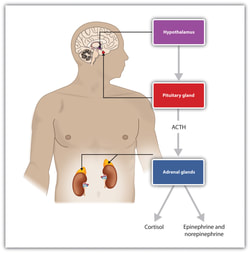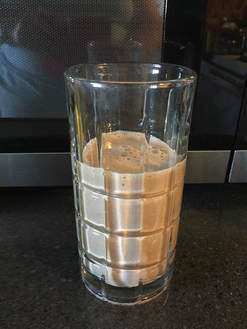|
Recently, I took part in a 10-day food reset called "Shred10" with a physician friend of mine. Part of the Shred was to drink 2 smoothies a day using JuicePlus Complete Protein Powder. I had already been drinking one smoothie in the morning and loving it, so I had to get creative with my smoothie recipes.
If you know me, you'll know I LOVE chocolate, but not just any chocolate - smooth, creamy, delicious chocolate. Here's what I came up with as my most favorite smoothie recipe: - 1 scoop Juice Plus Complete Powder - Get yours here - 2 cups hemp or almond milk - 1/4 tbsp almond butter - 1/2 small avocado - 1/2 of a medium banana - 1 teaspoon Brain Octane oil by Bulletproof - Can get this on Amazon or from Central Market - 1 drop therapeutic-grade Copaiba essential oil from Young Living for digestive and immune support - Get yours here as part of the Premium Starter Kit - 1 cup ice Add all the ingredients in to a blender (powder on the bottom is best so it doesn't fly everywhere). Blend. And enjoy this rich, creamy, anti-inflammatory smoothie. The omega-3s from the avocado, hemp/almond milk and almond butter help your brain and heart function properly and help stave off hunger. The fats in the MCT oil in Brain Octane oil do the same, so you shouldn't feel hungry for a few hours after drinking this smoothie. Using Juice Plus Complete Powder gives you multiple servings of fruits and vegetables that you may not be getting through your diet. Truth is, only 1 in 10 Americans gets the recommended 3-5 servings of fruits and vegetables daily! And Juice Plus has been studied clinically for improving bridging this gap in nutrients - www.juiceplus.com/us/en/clinical-research/clinical-research. How amazing! Don't forget to let me know what you think of my recipe and/or your favorite smoothie recipe. I'm all ears! :-) In Health, Dr. Maltz
0 Comments
What is adrenal fatigue and how do I know if I have it? Adrenal fatigue is a controversial diagnosis that many Holistic and Functional Medicine practitioners have come to know and address. It is basically dysfunction of the Hypothalamic-Pituitary-Adrenal (HPA) axis. This VERY important hormonal regulation system is the MASTER of our hormones and thus, of our health. Here’s a simplified image of this system:  Source: http://open.lib.umn.edu/intropsyc/chapter/10-2-stress-the-unseen-killer/ Accessed July 17, 2017. In my mind, the system works like a large ship. The captain of the ship is the Hypothalamus. He/She gives orders (in the form of releasing factors) to the Pituitary gland (the Skipper) located centrally in our brain. The Skipper (aka pituitary gland) is generally in charge of constantly checking in with the crew members to see if they are doing their tasks correctly. He/She is constantly giving orders to the hands-on crew whether to slow down, speed up or change the direction of the ship, according to the Captain’s orders. The pituitary does this by releasing or inhibiting a hormone called adrenocorticothalamic hormone (ACTH). ACTH acts on the adrenal glands to secrete various hormones (cortisol, sex steroids (testosterone and estrogen) and epinephrine/norepinephrine) that tell the muscles and nerves what to do (I’d consider these the crew as they are at the bottom of the totem pole of command. However, the crew also plays a crucial role in spotting things that are out of control (a storm or iceberg) and alerting the Skipper, who alerts the Captain. Obviously, this is just a simplified version of what actually occurs in our bodies. But I think it’s extremely important for all of us to understand that we are constantly in a state of checks and balances in our bodies. So how does this affect my body? When our stress levels or our bodies are under attack (think acute or chronic illness) are high, the stress hormones cortisol and adrenaline (epinephrine and norepinephrine) are pumped out to provide instructions to every muscle and nerve in our body and a whole host of reactions occur. (For the sake of simplicity, I’ll leave that for another blog post.) But when we are chronically stressed emotionally or physically (chronic or acute illness), our adrenals are on HIGH demand most of the day and sometimes at night. This abnormal response eventually “burns” our adrenals out and they become tired or over-reactive, secreting too much cortisol and adrenaline than is healthy. Once this occurs, daily activities become difficult. People suffering from this level of chronic adrenal under or over production are either excessively tired (under production) or excessively wired (overproduction). Adrenal dysfunction is being seen more and more in our society as we become more disconnected from nature and communities and more focused on technology and the latest newsfeed. People suffering from this dysfunction often have:
Many of them live on coffee and sugar to decrease their fatigue, not knowing that consumption of these products is actually contributing to their dysfunction. It’s a vicious cycle that people have a hard time side-stepping. So what can I do about it? I’m here to tell you, while chronic stressors affect ALL of us, the dysfunction or dysregulation of the adrenals CAN IMPROVE! And we are ALL at risk of developing Adrenal Fatigue (Dysfunction). In fact, I, myself, and many of my colleagues, have struggled with this condition over the years. We now work to educate and help people navigate treatment through lifestyle changes, herbs and nutritional support. My dysfunction was so severe that I quit my stressful job as an Academic Physician and spent 4 months not working to recover. The full recovery process actually took over a year as I’ve only recently been feeling more energized (1.5 years later) and have started pushing myself more athletically. In short, I had to learn how to treat myself and I now LOVE helping my patients detect and treat their Adrenal Dysfunction. I’d be honored to help you if you feel like your adrenals are dysfunctional. Sincerely, Dr. M Modern life is complicated.
We have the joy of information at the click of a mouse, luxuries of convenience delivered to our doorstep within 2 hours and the ability to communicate with people from around the world instantly. But, with all this technology, we are unfortunately exposed more and more to various toxins that can contribute to chronic illness. Here is my Top 10 list of toxins to avoid (as much as able. No one is perfect!): 1) Negative Beliefs & Emotions and News Media - I cannot stress to you how important your mindset and beliefs are for your health and wellness. Basically, what you believe about yourself and your health is what manifests. If you believe you are healthy, you will be. Conversely, if you believe you are going to get sick, you will. It's that simple! - So...be kind to yourself and don't watch TV news! 2) Toxic Relationships - associated with #1. - These relationships drain your energy and have you feeling negatively about yourself. See a therapist or qualified professional right away to learn how to manage/detach yourself from these relationships. 3) Phthalates – Found in plastics, vinyl flooring, building materials, personal care products, fragrances, children’s backpacks & lunch boxes - Associated with infertility, breast cancer, obesity and birth defects - This is one of the toxins I avoid using when I make my own personal care products or use those made with only the highest quality, therapeutic- grade essential oils instead of synthetic fragrances - Get yours --> here 4) BPA – Found in canned foods (liner), plastics, baby bottles - Associated with obesity, thyroid disease, asthma, increased cancer risk and increased rates of anxiety, depression hyperactivity and aggression in children 5) Lead – Found in lead paint, leaded gasoline and in some lipsticks 6) Mercury – From dental amalgams. - Neurotoxic. Have these removed ASAP by a certified biological dentist 7) Volatile Organic Compounds (VOCs) – Found in paint, air freshener, new furniture/ car and carpentry (formaldehyde) - Causes sick building syndrome, allergic reactions, asthma, respiratory illness - This is one of the toxins I avoid using when I make my own personal care products or use those made with only the highest quality, therapeutic- grade essential oils instead of synthetic fragrances - Get yours --> here 8) Mold – Toxic to entire system if left untreated 9) Glyphosate – pesticide used to promote bigger yields in food - Found in GMO foods and soil in which it's grown - Associated with metabolic disease and cancer 10) Light/noise pollution - Use ear plugs in noisy places, decrease volume of earbuds and headphones and use your Night Shift phone setting while watching TV or using the internet at night - They decrease the exposure to stimulating blue light at night The point of this post is not to overwhelm you. It is to EMPOWER you to make better decisions about food, products and services you consume everyday. Please reach out with questions. In Health, Dr. Maltz |
AuthorDr. Maltz earned a Medical Degree and Master in Public Health from the University of Texas Medical Branch (UTMB) in Galveston, TX. She completed a combined Internal and Preventive Medicine Residency at UTMB in June, 2011. She then completed a 2-year Integrative Medicine Fellowship at Stamford Hospital in Stamford, CT, during which she simultaneously underwent an intensive 1000-hour curriculum created by The University of Arizona Integrative Medicine Program founded by Dr. Andrew Weil. Archives
October 2020
Categories
All
|
 RSS Feed
RSS Feed

